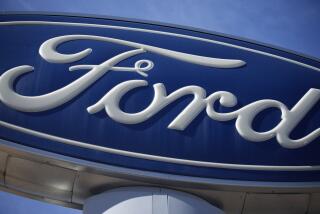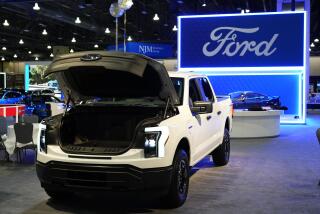In reversal, Ford brags it has smallest engines in the industry
- Share via
In a once unthinkable turnabout, Ford Motor Co. is bragging about how it now makes some of the smallest car engines in the industry. This is coming from a company that once made its money selling big, powerful trucks, SUVs and the Mustang muscle car.
Ford’s race to smaller engines represents a trend in the industry as all automakers woo fuel-conscious consumers and work to meet increasingly stringent fuel-economy standards, said Jesse Toprak, an analyst at TrueCar, an auto price information company.
“We believe that we are going to pay more for energy going forward and that fuel efficiency is the top reason to buy. That is going on all around the world now,” said Alan Mulally, Ford’s chief executive, in an interview with The Times this week.
Mulally said that Ford’s strategy of making powerful but smaller engines is part of the automaker’s goal to “increase the fuel efficiency every year forever.”
Ford has focused on small turbocharged engines, which it calls its EcoBoost line. Although Ford vehicles with these engines carry a premium over standard models, they have among the quickest paybacks from gas savings in the industry, Toprak said.
A recent TrueCar analysis of the latest industry offerings of small but powerful engines – with and without turbochargers - found that the Mazda3 with the SkyActiv engine and transmission was the best economic proposition. The Mazda engine features a high compression ratio and avoids the added expense of a turbocharger.
Chevrolet’s tiny Sonic with the EcoTec engine had the second-quickest payback.
Ford excelled at building big vehicles with small engines. Its Edge sport utility vehicle with the EcoBoost four-cylinder engine was third, and its big F-150 pickup truck with a six-cylinder EcoBoost engine was fifth.
The small Kia Forte sedan was fourth in the TrueCar analysis.
Ford is now marketing that with new introductions later this year, it will have seven vehicles with the smallest engines in their respective segments.
They include the 1.6-liter four-cylinder engines going into the new Escape crossover and Fusion family car, the 2-liter four-cylinder that’s already in the Edge SUV, its bigger Explorer sibling and the Taurus large sedan and a 3.5-liter V-6 it is placing in police Interceptors and F-150 pickup truck.
Ford and other automakers have downsized by making engines with equal or greater power than the engines they replace.
Ford, for example, said the 1.6-liter four-cylinder turbocharged engine that will go into the Fusion that comes out later this year is smaller than the 2.5-liter four-cylinder in the current base model of the Fusion, yet it will have slightly more horsepower and a double-digit percentage increase in fuel economy.
Toprak said Ford’s strategy is already paying off particularly well in truck sales.
“The fact that V-6 engines now make up over 50% of F-150 sales would have been simply unthinkable five years ago,” Toprak said.
Executives within the automaker debated the wisdom of putting smaller engines in the truck, which has been the bestselling vehicle in America for years, Mulally said.
“Maybe the truck owners wouldn’t be as interested in fuel economy,” he said. But when an earlier version of the F-series fell behind a competitor’s offering by one to two miles per gallon, “I’ve never seen so many comments from our truck owners … whether it’s a Fiesta, or whether it’s an F-150, they want absolutely the best fuel economy.”
RELATED:
Electric cars beat gas? Maybe not
Hybrid buyers don’t repeat the purchase
Prices for late model used car prices continue to rise
More to Read
Inside the business of entertainment
The Wide Shot brings you news, analysis and insights on everything from streaming wars to production — and what it all means for the future.
You may occasionally receive promotional content from the Los Angeles Times.











